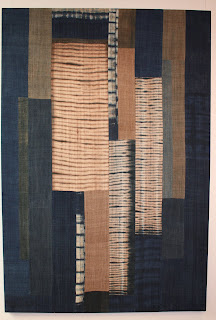
Frank Connet. Estuary II. 2008. Indigo and walnut dye on handwoven hemp, 71.5" x 48.5". Courtesy of The Douglas Dawson Gallery.
"Memories of nature form the basis of my art. The rhythms and patterns of a leaf’s radiating lines, the cycles of growth and decay, the confluence of waters and silted sand created by currents are echoed in these cut and pieced textile hangings.
Line and form are created using the Shibori process. A series of hand sewn stitches are drawn tight to bunch or pleat the fabric into a dense mass which is then dyed. The process permanently alters the surface of the wool, hemp or cotton, creating lines, ridges and washes, both of color and texture. Layered natural dyes of indigo, madder root, cochineal, walnut husks and black oak bark, alone or in combination, create a limitless palette of hue and depth. Dye on fiber creates a density of color that continues to fascinate me.
"My work in textile conservation has deeply influenced my art. Studying and restoring a wide variety of ancient and historic textiles has allowed me the opportunity to appreciate pre-industrial image making and dyeing techniques. The fabric of a Japanese farmer’s patched and repaired indigo dyed kimono, the rhythm in a West African strip woven wrapper or the irregular geometry in a Peruvian funerary tunic provides a continuous source of instruction and inspiration."
His craftsmanship in using natural dyes with textiles such as handwoven hemp is evident in his two pieces -- Estuary II and Rift -- in the show. Using the Japanese Shibori dyeing technique, which uses pulled threads and clamps, he often dyes each piece of fabric up to 30 times to get the desired effects --layers upon layers of hue variations or repetitive pattern formations.

Estuary II, detail

Estuary II, detail
After he completes the dyeing process, he cuts the fabric and creates a collage to complete the composition. The individual elements are machine sewn to form the piece and then hand quilted to create texture. When the sewing is completed, he then attaches a lining to the back of the entire piece and then mounts the piece to a stretcher.

Frank Connet. Rift. 2008. Indigo and walnut dye on handwoven hemp, 46.5" x 78.5". Courtesy of The Douglas Dawson Gallery.

Rift, detail
The following is a write-up in the Chicago Connection: The 5 Artists Project catalogue, which was published in August, 2008.
Frank Connet
Contact: 6140 W. North Avenue, Chicago, IL 60639
Phone: 773.637.7007
Email: Textileres@aol.com
Website: http://www.frankconnet.com/
Background
- Textile restorer and artist with more than 20 years of professional experience
- BFA, Kansas City Art Institute, Kansas City, MO
- Teaching experience: Penland School of Craft, 2008; Visiting Artist, Kansas City Art Institute, MO; Evanston Art Center, Evanston, IL; Southern Illinois University, Fiber
- Gallery representation: Textile-based work, Douglas Dawson Gallery, Chicago; works on paper, Kate Hendrickson Fine Art, Chicago; Jane Sauer Thirteen Moons Gallery, Santa Fe, NM
- Exhibiting since the mid 1980s; started showing textile work in 1998
Selected Exhibitions
Material Difference, Group Show, Chicago Cultural Center, 2007; Clamped and Bound, Solo Exhibition, Douglas Dawson Gallery, Chicago, 2007; Silk Road Oasis, Illinois Artisan Program, Chicago Tourism Center, 2006; Frank Connet & Jiro Yonezawa, Jane Sauer Thirteen Moons Gallery, Santa Fe, NM, 2006; Fiberart Interantional 2004, Bellevue Art Museum, Bellevue, WA, 2005; Gift, Bequest, and Purchase: A Selection of Textile Acquisitions, 1998-2003, the Art Institute of Chicago, 2004-05; Fiberology: Six Extraordinary Contemporary Fiber Artists, Montgomery College Art Gallery, Rockville, MD; Museum of Arts & Design, New York, 2004; SOFA Chicago 2003, Heltzer, Navy Pier, Chicago
As a textile conservationist, Frank Connet has had the opportunity to study, analyze, and restore museum-quality historic textiles. With this knowledge and his interest in natural dyeing techniques, he creates abstract textile wall hangings that are “quilted” paintings, reminiscent of natural hand-dyed Japanese kimonos or West African strip woven textiles.
His artistic process starts with natural dyes and fabrics, which he sews and pleats and then dyes on average thirty to forty times to achieve the desired colors and patterns. He uses the Japanese Shibori process: “A series of hand-sewn stitches are drawn tightly to bunch or pleat the fabric into a dense mass, which is then dyed. The process permanently alters the surface of the wool, hemp or cotton, creating lines, ridges and washes, both of color and texture. Layered natural dyes create a limitless palette of hue and depth.” After the dyeing process, the fabrics are dried, cut, sewn, and pieced into textile hangings. He also creates Shibori “sculptural” pieces, which are many yards of dyed fabric pulled tightly into a three-dimensional form.
Many of his pieces are inspired by nature – transitions, cycles, patterns, symbols, and structures. His compositions are a series of mainly geometric shapes in monochromatic blues, grays, and browns, sometimes enlivened with a dash of red or yellow. What makes his pieces come alive is his instinctive layering of monochromatic blues, showing hidden depth in the background, and on top of that, a series of rectangles with different colors and line patterns, almost symbolizing windows into the unknown if one dares to look through them.
No comments:
Post a Comment